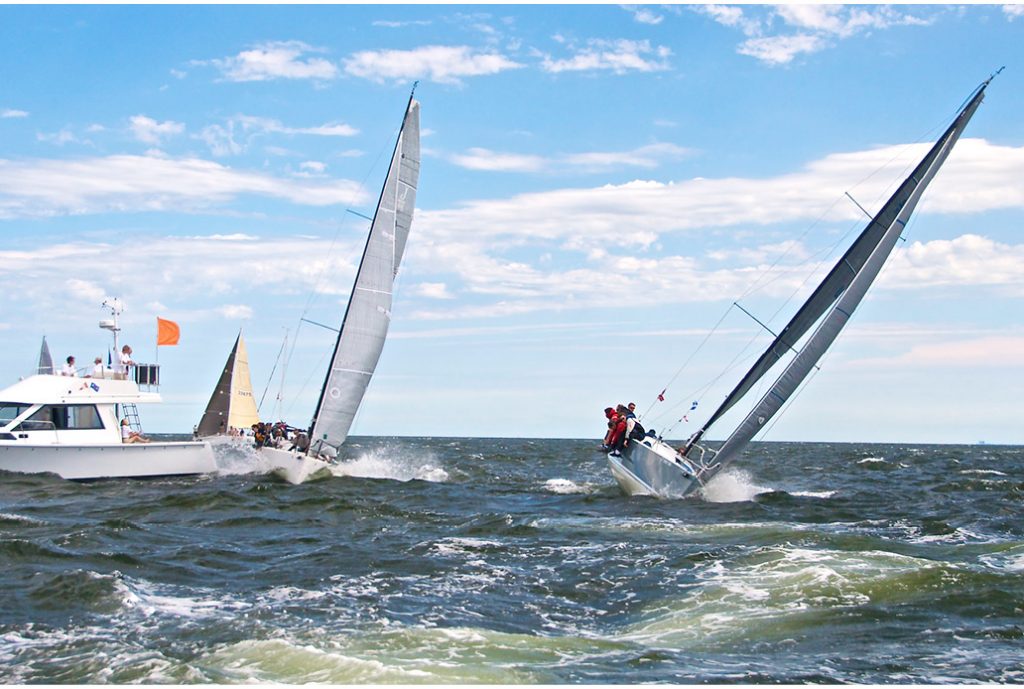When boats converge at the finish line and you’re fighting for every inch of real estate, it definitely helps to have a good working knowledge of the racing rules. You need to know the basic right-of-way rules, of course, but there are also quite a few rules that apply uniquely when you are finishing. Here are some questions that are frequently asked about those rules.

The definition of “Finish” says that a boat finishes when any part of her hull, crew or equipment in normal position crosses the finishing line. In other words, if a part of your crew or equipment is not in normal position, that part does not count for finishing.
© Rick Bannerot/OntheFlyPhoto.net
Once I finish the race, can I forget the rules? Not exactly. The Racing Rules of Sailing apply as long as you “are sailing in or near the racing area.” This means that before, after and in between races, boats must abide by the same rules that apply while racing. For example, port tack must keep clear of star- board. However, you can be penalized for breaking a rule in Part 2 (When Boats Meet) only when you are “racing.” The definition says a boat is racing from her prep signal “until she finishes and clears the finishing line and marks…”
So, after I finish and clear the finish line I can’t be penalized for breaking a right-of-way rule? In most cases, that’s right. You could be held responsible if you break a rule and the result is damage or injury, but you won’t be penalized under the racing rules. However, rule 24.1 says a boat that is not racing shall, if reasonably possible, avoid interfering with a boat that is racing. So if you finish but then obstruct a boat that’s still racing, you can be penalized (even if you had the right of way).
Once I finish, can I scull or paddle to clear the finish line? No. Sculling and paddling are prohibited by rule 42 (Propulsion). Since rule 42 applies all the time while you are racing, you can be penalized if you scull or paddle (or do any other illegal kinetics) before you finish and clear the finishing line and marks. From my experience on race committees, I would say this is one of the most misunderstood rules, especially among youth sailors.
How do I exonerate myself if I hit a finish mark? The process is just the same as when you touch any other mark. You must get well clear of other boats as soon as possible and then promptly make one turn including one tack and one jibe. You can make this penalty turn anywhere (including the finish side of the line), but you must then sail completely to the course side of the line before you finish (see rule 44.2 and the definition “Finish”).
If I don’t hit the finish mark until after I finish the race, do I still have to make a penalty turn? Good try! Rule 31 (Touching a Mark) applies all the time while you are racing, so if you touch a finish mark before you have “finished and cleared the finishing line and marks” then you must do a penalty turn. This is similar to touching a starting mark before you start; if it’s after your preparatory signal you are racing and therefore must make a penalty turn.
Do I have to cross the finish line completely after I finish? No! According to rule 28.1, “After finishing she need not cross the finishing line completely.” Though most boats get their bow across the line and then keep going in that direction, it’s certainly possible to clear yourself by going the other way.
After I finish, do I have to tell the race committee that I intend to file a protest? Here’s another misunderstood rule. The Racing Rules of Sailing do not require you to inform the race committee at the finish in order to make your protest valid. However, this extra requirement may be added by the sailing instructions, which are permitted to change the protest procedure. So make sure you read your SIs carefully since they might, for example, require you to hail the sail number of the boat you’re protesting, or specify a certain RC boat to which you must report.
If I cross the finish line in the wrong direction, can I correct this error? Yes! The definition of Finish says you must cross the finish line from the course side. If you cross it going the other direction, you won’t be scored as finishing. However, according to rule 28.2, if a boat passes a mark on the wrong side she can correct this error. ■
This article originally appeared in David Dellenbaugh’s Speed & Smarts, The newsletter of how-to tips for racing sailors. If you want to sail faster and smarter, log onto SpeedandSmarts.com.
A resident of Easton, CT, Dellenbaugh was tactician and starting helmsman for America3’s successful defense of the America’s Cup in 1992. He’s a Lightning World Champion, two-time Congressional Cup winner, seven-time Thistle National Champion, two-time winner of the Canada’s Cup, three-time Prince of Wales U.S. Match Racing Champion, and a winner of the U.S. Team Racing Championships for the Hinman Trophy.



